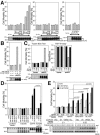Transforming growth factor beta2 is a neuronal death-inducing ligand for amyloid-beta precursor protein
- PMID: 16227582
- PMCID: PMC1265827
- DOI: 10.1128/MCB.25.21.9304-9317.2005
Transforming growth factor beta2 is a neuronal death-inducing ligand for amyloid-beta precursor protein
Abstract
APP, amyloid beta precursor protein, is linked to the onset of Alzheimer's disease (AD). We have here found that transforming growth factor beta2 (TGFbeta2), but not TGFbeta1, binds to APP. The binding affinity of TGFbeta2 to APP is lower than the binding affinity of TGFbeta2 to the TGFbeta receptor. On binding to APP, TGFbeta2 activates an APP-mediated death pathway via heterotrimeric G protein G(o), c-Jun N-terminal kinase, NADPH oxidase, and caspase 3 and/or related caspases. Overall degrees of TGFbeta2-induced death are larger in cells expressing a familial AD-related mutant APP than in those expressing wild-type APP. Consequently, superphysiological concentrations of TGFbeta2 induce neuronal death in primary cortical neurons, whose one allele of the APP gene is knocked in with the V642I mutation. Combined with the finding indicated by several earlier reports that both neural and glial expression of TGFbeta2 was upregulated in AD brains, it is speculated that TGFbeta2 may contribute to the development of AD-related neuronal cell death.
Figures








Similar articles
-
Characterization of V642I-AbetaPP-induced cytotoxicity in primary neurons.J Neurosci Res. 2004 Jul 1;77(1):54-62. doi: 10.1002/jnr.20139. J Neurosci Res. 2004. PMID: 15197738
-
A mutation protective against Alzheimer's disease renders amyloid β precursor protein incapable of mediating neurotoxicity.J Neurochem. 2014 Jul;130(2):291-300. doi: 10.1111/jnc.12717. Epub 2014 Apr 10. J Neurochem. 2014. PMID: 24646423
-
TAG-1 is an inhibitor of TGFbeta2-induced neuronal death via amyloid beta precursor protein.Biochem Biophys Res Commun. 2010 Mar 26;394(1):119-25. doi: 10.1016/j.bbrc.2010.02.127. Epub 2010 Feb 23. Biochem Biophys Res Commun. 2010. PMID: 20184861
-
Cellular signaling roles of TGF beta, TNF alpha and beta APP in brain injury responses and Alzheimer's disease.Brain Res Brain Res Rev. 1997 Feb;23(1-2):47-61. doi: 10.1016/s0165-0173(96)00014-8. Brain Res Brain Res Rev. 1997. PMID: 9063586 Review.
-
Amyloid Precursor Protein family as unconventional Go-coupled receptors and the control of neuronal motility.Neurogenesis (Austin). 2017 Mar 1;4(1):e1288510. doi: 10.1080/23262133.2017.1288510. eCollection 2017. Neurogenesis (Austin). 2017. PMID: 28321435 Free PMC article. Review.
Cited by
-
Synaptic Cell Adhesion Molecules in Alzheimer's Disease.Neural Plast. 2016;2016:6427537. doi: 10.1155/2016/6427537. Epub 2016 May 3. Neural Plast. 2016. PMID: 27242933 Free PMC article. Review.
-
Single-cell analysis reveals specific neuronal transition during mouse corticogenesis.Front Cell Dev Biol. 2023 Nov 6;11:1209320. doi: 10.3389/fcell.2023.1209320. eCollection 2023. Front Cell Dev Biol. 2023. PMID: 38020907 Free PMC article.
-
PAT1 inversely regulates the surface Amyloid Precursor Protein level in mouse primary neurons.BMC Neurosci. 2015 Mar 7;16:10. doi: 10.1186/s12868-015-0152-8. BMC Neurosci. 2015. PMID: 25880931 Free PMC article.
-
Underlying Mechanisms of Brain Aging and Neurodegenerative Diseases as Potential Targets for Preventive or Therapeutic Strategies Using Phytochemicals.Nutrients. 2023 Aug 4;15(15):3456. doi: 10.3390/nu15153456. Nutrients. 2023. PMID: 37571393 Free PMC article. Review.
-
TGF beta2-induced changes in LRP-1/T beta R-V and the impact on lysosomal A beta uptake and neurotoxicity.Brain Res. 2008 Nov 19;1241:176-87. doi: 10.1016/j.brainres.2008.08.086. Epub 2008 Sep 10. Brain Res. 2008. PMID: 18804458 Free PMC article.
References
-
- Amara, F. M., A. Junaid, R. R. Clough, and B. Liang. 1999. TGF-β1, regulation of Alzheimer amyloid precursor protein mRNA expression in a normal human astrocyte cell line: mRNA stabilization. Brain Res. Mol. Brain Res. 71:42-49. - PubMed
-
- Armstrong, R. A. 1994. Differences in beta-amyloid (β/A4) deposition in human patients with Down's syndrome and sporadic Alzheimer's disease. Neurosci. Lett. 169:133-136. - PubMed
-
- Bodmer, S., M. B. Podlisny, D. J. Selkoe, I. Heid, and A. Fontana. 1990. Transforming growth factor-β bound to soluble derivatives of the β amyloid precursor protein of Alzheimer's disease. Biochem. Biophys. Res. Commun. 171:890-897. - PubMed
-
- Cairns, N. J., A. Chadwick, P. L. Lantos, R. Levy, and M. N. Rossor. 1993. βA4 protein deposition in familial Alzheimer's disease with the mutation in codon 717 of the βA4 amyloid precursor protein gene and sporadic Alzheimer's disease. Neurosci. Lett. 149:137-140. - PubMed
-
- Chalazonitis, A., J. Kalberg, D. R. Twardzik, R. S. Morrison, and J. A. Kessler. 1992. Transforming growth factor β has neurotrophic actions on sensory neurons in vitro and is synergistic with nerve growth factor. Dev. Biol. 152:121-132. - PubMed
Publication types
MeSH terms
Substances
LinkOut - more resources
Full Text Sources
Molecular Biology Databases
Research Materials
Miscellaneous
